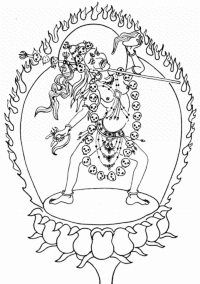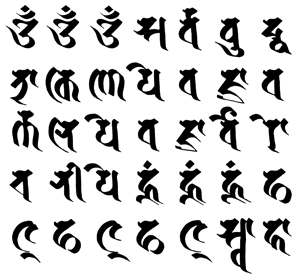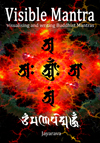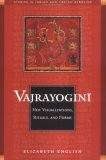
Vajrayoginī is a tantric deity with no counterpart in Mahāyana Buddhism. She is a ḍākiṇī- literally a "sky-dancer", and figuratively a wild spirit who dances ecstatically in the clear blue sky of śūnyata. She is usually depicted as blood red in colour, naked except for elaborate ornaments of human bone, and a necklace of skulls, corresponding to the sixteen vowels and thirty-four consonants of the Sanskrit alphabet, and symbolising the purification of speech. In her right hand she holds a flaying knife with a vajra handle - a vajra-chopper - which she uses to cut off attachments. In her left hand is a skull cup filled with mahāsukha (the great bliss) which she pours out like wine to her devotees. In the crook of her left arm she cradles a khatvanga or magic staff. Her iconography is rich and multifaceted.
Practices and mantras associated with Vajrayoginī are often considered secret - although the mantras are now widely published. Many traditional practitioners are uncomfortable with this breaking of the traditional secrecy around these practices, and warn against using these mantras without proper instruction.
Short Mantra
Siddhaṃ

Tibten - Uchen

Transliteration
oṃ va jra yo gi nī hūṃ pha ṭ svā hā
oṃ vajrayoginī hūṃ phaṭ svāhā
Tibetan Transliterationoṃ ba zra yo gi nī hūṃ pha ṭa svā hā
Long Mantra
This mantra is one that I have received several inquiries about, questioning the wisdom of making it available. I am sympathetic to these concerns. This mantra is from the Anuttara Yoga Tantra - the most esoteric and generally speaking most secret level of Tibetan Buddhism. While the lower (or outer) Tantras are often treated as open and accessible to the public, many people consider this mantra to be "secret". It is something of an open secret however as there are several books which reveal it, and many internet sites. Andy Weber, a very well known Western practitioner of Tibetan artistic traditions, has made the mantra into a postcard!
In the Western Buddhist Order we do not necessarily approach mantra on the terms of Tibetan Tantric Buddhism - I am working on an account of this approach but it is not yet ready. That said, Dharmacari Vessantara, our foremost authority on these matters, has been one of those expressing misgivings. At present I am inclined to leave the mantra here, but will entertain further feedback, and leave open the possibility of removing it. I have taken pains to make sure my rendition is at least accurate and reliable as to spelling which other websites have not.
From the traditional point of view this mantra should be used under the guidance of a qualified teacher. Especially if you are involved in a Tibetan Tradition you should consult your Buddhist teacher if you want to use this mantra in your practice. Vajrayoginī practices require specific initiations and carry samaya vows.
Siddhaṃ

Transliteration
oṃ oṃ oṃ sa rva bu ddha
ḍā ki ṇī ye va jra va
rṇa nī ye va jra vai ro
ca nī ye hūṃ hūṃ hūṃ pha
ṭ pha ṭ pha ṭ svā hā
oṃ oṃ oṃ sarvabuddhaḍākiṇīye vajra varṇanīye vajra vairocanīye hūṃ hūṃ hūṃ phaṭ phaṭ phaṭ svāhā
ओं ओं ओं सर्वबुद्धडाकिणीये वज्र वर्णनीये वज्र वैरोचनीये हूं हूं हूं फट् फट् फट् स्वाहा
Notes
I'm still researching the origins of the short mantra, i.e. the one used in the Western Buddhist Order
A lot more information about Vajrayoginī can be found on the vajrayogini.com website.



 Vajrayogini: Her Visualisations, Rituals and Forms.
Vajrayogini: Her Visualisations, Rituals and Forms.